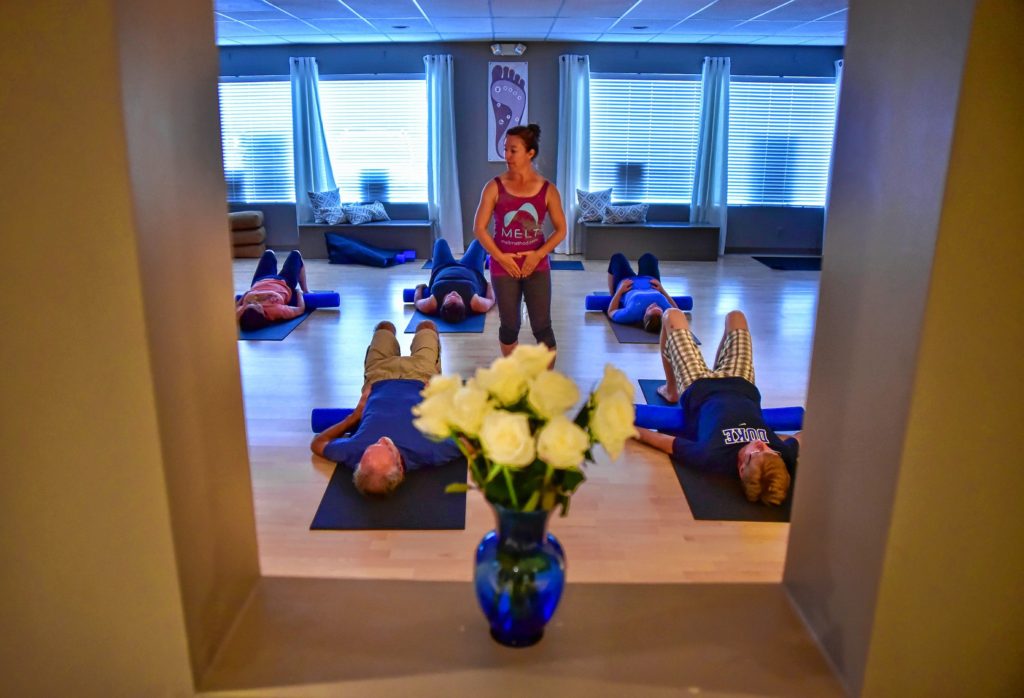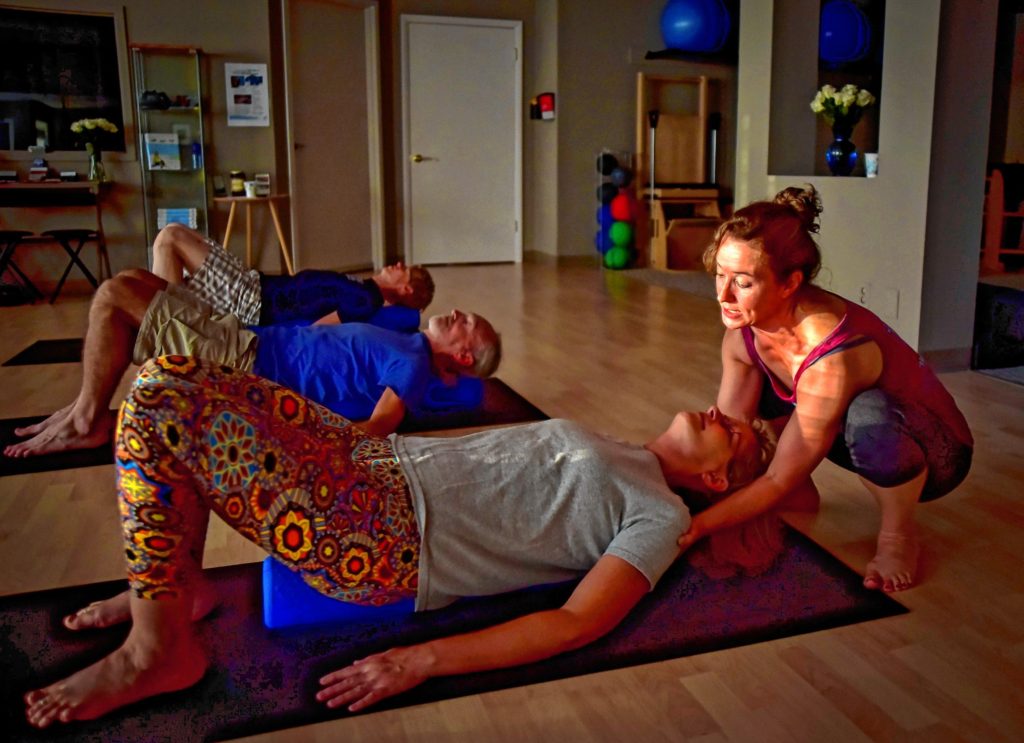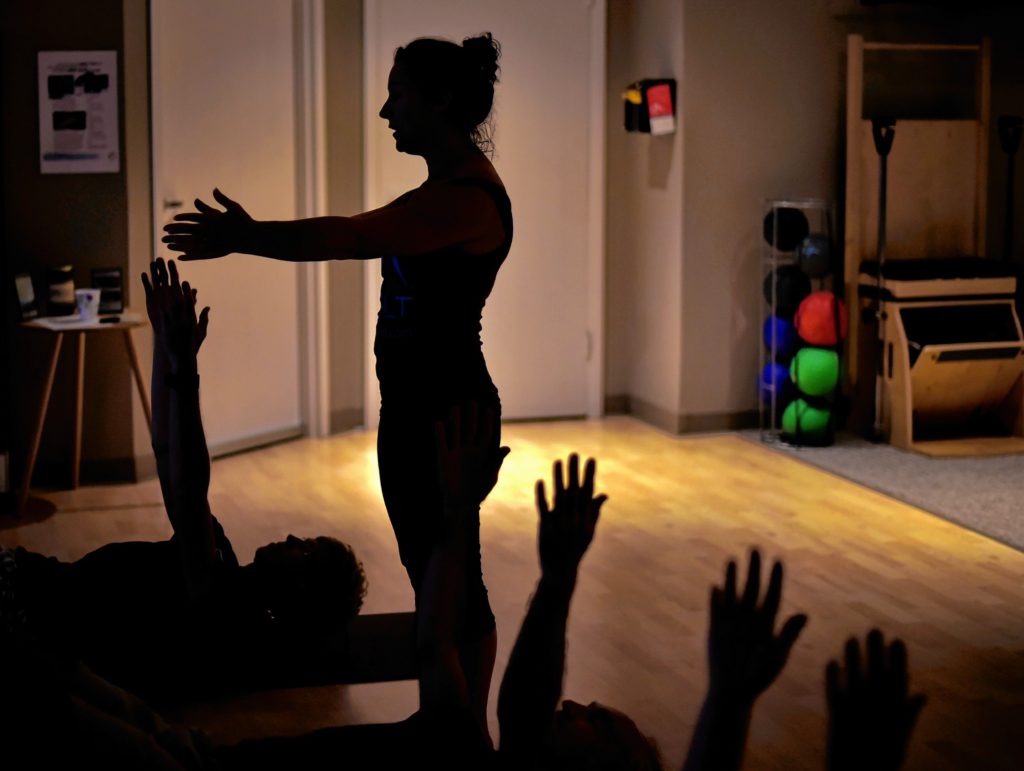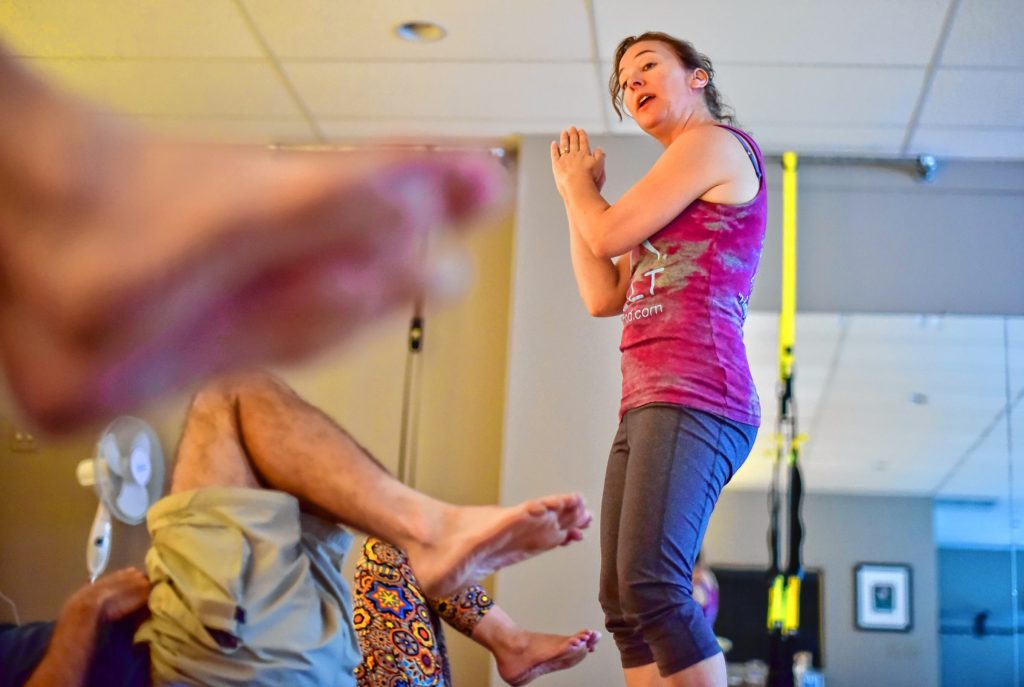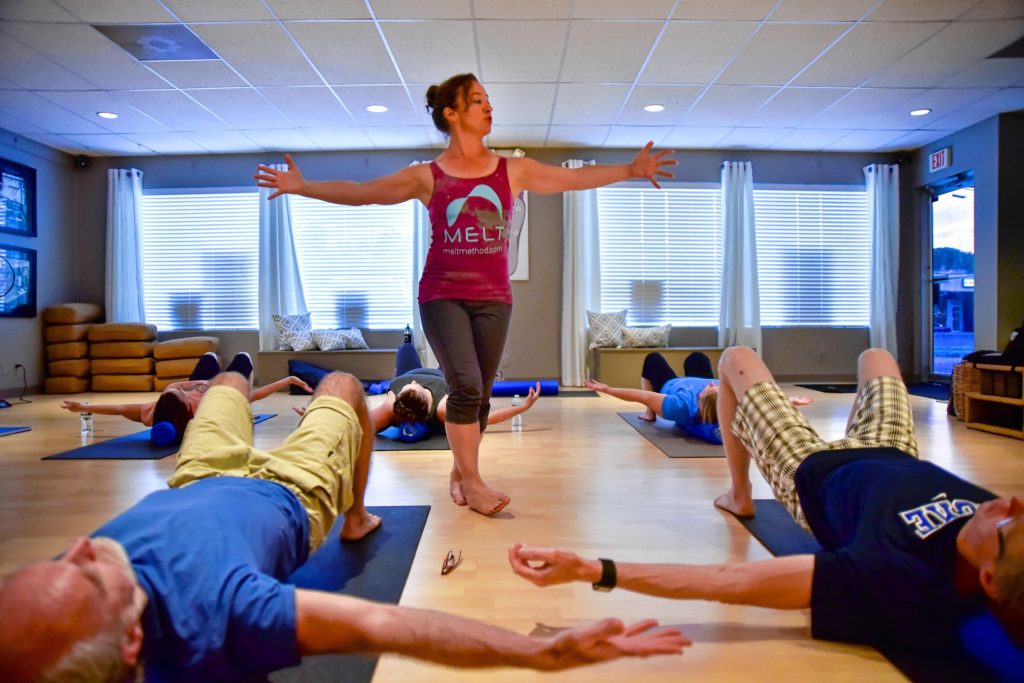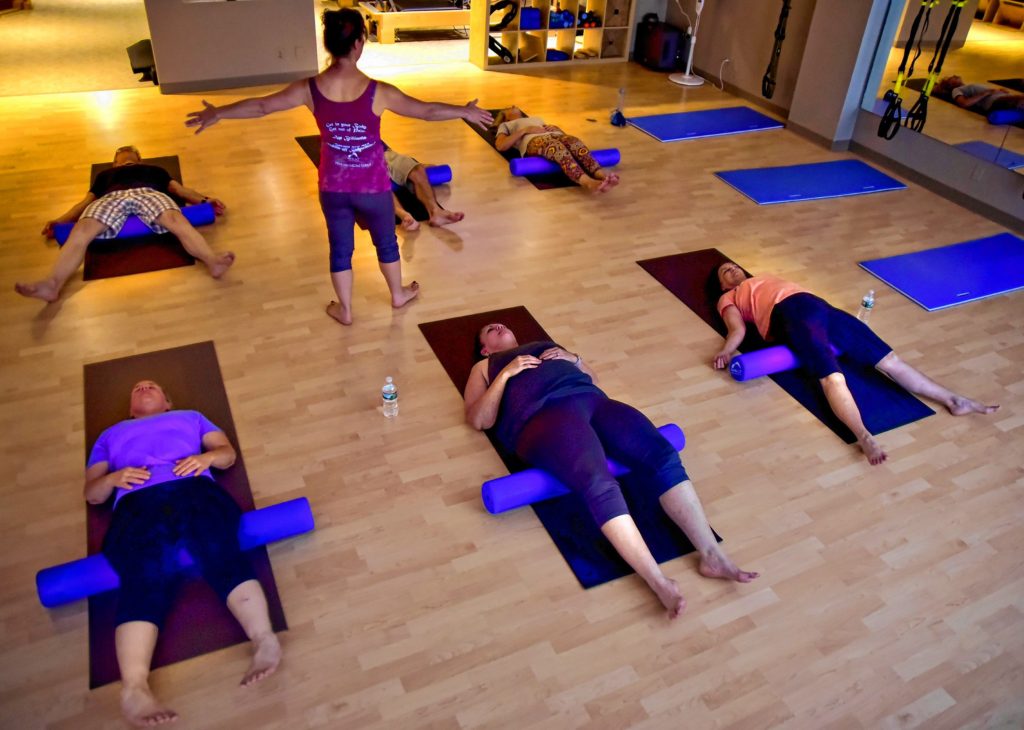Kerrie Bodendorf, a 47 year-old mother of three from Westfield, had all but given up hope of finding relief for her debilitating chronic back pain, which often confined her to her couch for weeks at a time. But in 2010, she accidentally stumbled onto a self-treatment technique that she says changed everything.
“MELT gave me my life back,” said Bodendorf.
MELT, which stands for Myofascial Energetic Length Technique, is a series of exercises that work on the fascia — the body’s internal mesh that lines the entire body from head to toe. This connective tissue surrounds every joint, muscle, nerve, bone and organ.
Using soft foam balls and rollers, the individual performs a variety of gentle sequential movements which are said to keep the fascia hydrated, rebalance the nervous system, and restore space to compressed joints.
“I could just be walking, or cough or sneeze and I would be in debilitating pain,” Bodendorf said of her condition before MELT.
“Then of course I was so afraid to move that I wasn’t exercising either.” Bodendorf said that she wanted to avoid surgery and painkillers, so she was always searching for a natural way to relieve her pain.
MELT came into Bodendorf’s life one day in March 2010 when her TV just happened to be tuned in to the Regis and Kelly show.
Sue Hitzmann was on.
“I had never seen the show before and I have never seen it since,” Bodendorf said, “but that day there was this woman on talking about things like chronic pain, fatigue, and body aches. I felt as though she was talking directly to me and found that I kept saying ‘yes, yes, I have that!’ ” Hitzmann, a nationally recognized educator, manual therapist, exercise physiologist and founding member of the Fascia Research Society, created the MELT method in which the individual moves with the foam rollers and balls on various parts of the body.
Bodendorf, who also had severe pain from a bunion she acquired from years of wearing high heels to work, began practicing the MELT Hand and Foot Treatment — rolling the small MELT balls over the hands and feet.
She says her pain began to subside.
“It was miraculous. My back began to feel better within a month or two and the bunion took more like three months to really feel better,” she said.
“It really depends on the individual body and how long you have had the particular issue.”
Within two months Bodendorf found herself in New York City to train with Hitzmann to become an instructor.
Now, not only does she teach MELT classes, she helps to train MELT instructors throughout the country, and also teaching dance fitness, Zumba, TRX (Total Body Resistance Exercise) Cross Fit and Hatha Yoga.
“If someone had told me when I was 40 that I would be teaching dance and fitness I would have called them a liar!” Bodendorf said with a laugh.
“MELT just fell in my lap, but now it is such a passion of mine,” she said. “It is great to be able to help people get out of pain and then to be there when they realize they can do it for themselves and they don’t need me.”
As exercise and rehabilitation help the musculoskeletal system, the MELT method addresses the neurofascial system, Bodendorf says.
The movements involved release accumulated tension and stress, or what the method refers to as “stuck stress.” According to Hitzmann, this stuck stress builds up and causes dehydration in the connective tissue, which in turn interferes with the nervous system’s ability to regulate itself, slowing down the body’s natural healing process.
Bodendorf says the balls and rollers are far softer than the standard gym rollers and are used in a very slow and deliberate manner that has no resemblance to working out tight muscles or engaging in a stretching routine.
The technique is based in three basic movements — “gliding,” “shearing” and “rinsing” which instructors teach their students to use themselves.
Gliding is used to explore the tissue for restrictions and uses two directional compression movements by gently rolling a ball or roller using small movements in a certain spot on the area of the body. Shearing combines small, multi-directional movements with specific pressure to stimulate fluid production deep within the connective tissue. Rinsing applies pressure moving in one direction to optimize the flow of connective-tissue fluid throughout the body.
Bodendorf says MELT can improve flexibility, alignment and posture, joint mobility, sleep, digestion and overall well-being, as well as reducing aches and pains, tension and stress, headaches, and the risk of injuries.
Because fascia is primarily made of collagen, the MELT exercises also help reduce the appearance of cellulite as well as wrinkles in the skin, she said.
“My mother had arthritis in her hand and it was stuck in a claw position. The soft ball and hand treatment really helped her with that,” Bodendorf said.
“She is a knitter, she sews and she is a quilter, and while MELT doesn’t cure arthritis, it gives the body more glide and slide.”
Joyce Peirce, 52, of Great Barrington was a student of Bodendorf and sees her as a mentor.
“She is a wonderful person to learn from,” Peirce said.
Peirce had suffered upper back pain caused from sitting in her car during long commutes to work.
In 2012 she took a class with Bodendorf.
“I felt immediate relief in the class,” Peirce said. “And I really liked that I could come home and use what I had learned to deal with the problem.”
Like Bodendorf, Peirce was so impressed with the MELT Method that she became an instructor in 2013 and now teaches in the Berkshires at Berkcirque in Great Barrington, and Healing Rhythms in Lenox.
“Kerrie is still a mentor to me,” Peirce said.
Bodendorf teaches classes at Life Dance on Cherry Street in Westfield and The Pilates Studio on Walnut Street Ext., Agawam, and travels to a variety of venues to offer classes and workshops.
She says her first class is an introductory workshop on what causes aches and pains. It also includes information on what connective tissue is, and what MELT can do for the body, Bodendorf said.
Dawn Nooney, 41 is the owner of Renew.calm in West Springfield. “She did a seminar here in March and it was awesome,” Nooney said. “I loved her great enthusiasm and how she makes it fun and light while she also really gets into the details and the mechanics.”
Nooney said MELT has helped her gain more flexibility in her hamstrings, which has helped her with her horseback riding.
“It is pretty amazing. It seems so simple that you think you can’t possibly be doing anything, but the changes are dramatic,” she said.
Bodendorf says that MELT is not just for people in pain, but can benefit anyone who wants to maintain a fit, healthy body and achieve optimal physical performance. She also notes that the method is conducive to helping individuals with injuries or mobility issues and those who are at any level of fitness.
“You just have to remember it is like brushing your teeth, you have to keep it up to have it work,” Bodendorf said. “If I go for a week without MELTing, my body lets me know about it.” Bodendorf said that MELTing takes just 10 minutes a day, three times a week to make a difference in how your body feels.
And that, she says, can affect a person’s mood and outlook. Before MELT, she says, she had extreme anxiety that prevented her from participating in public activities.
These days, she frequently travels around the country on her own, confidently training students and instructors.
“I love being out of pain, I love what I do and I love helping others,” she said.
Fran Ryan is a freelance writer who lives in Easthampton.

